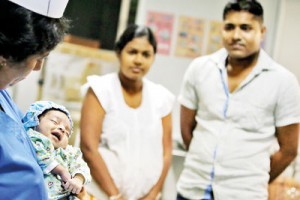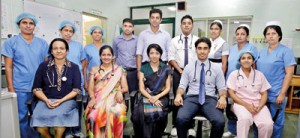Lanka’s first ECMO baby wins battle between life and death

Little Sehandu smiles in his sleep unaware of all the anguish his parents went through. Pix by M.A. Pushpa Kumara
Sehandu Suhasvin — it was just this Wednesday that Tharindu Dhanushka and Nayomi Ishanka named their firstborn son.
Sudu sanda (white moon) and mana usas bava (sublime) is what the baby’s name means, the couple says smilingly, but what is left unsaid for a moment is more poignant.
Yes, the family did check the auspicious letters with which his names should begin according to the time of his birth on the night of February 26, but there was hesitancy, for his nekatha indicated that he was facing a ‘bad period’ which would end on March 3.
What the nekatha did not tell them was that the major battle between life and death that their baby was compelled to face as soon as he saw the light of day and the newborn being sent to the right place at the right time would save his life.
Tiny Sehandu sleeping peacefully in the Neonatal Intensive Care Unit (NICU) of the Karapitiya Teaching Hospital or being held close by his Ammi bringing forth a yawn and then a smile even though his eyes are shut in slumber, is the harbinger of good tidings for numerous at-risk newborns.
His little heart beats normally and his little lungs are functioning as they should because of Extracorporeal Membrane Oxygenation (ECMO), a first in Sri Lanka.
“This is the first successful mechanical cardiopulmonary support in neonatal critical care,” explains Consultant Cardiothoracic Surgeon, Dr. Tolusha Harischandra, pointing out that ECMO is “a form of temporary support of the lungs and/or heart, for severe respiratory and/or cardiac failure not amenable to conventional forms of treatment”.
It is thereafter that Consultant Paediatrician Dr. Kapilani Withanaarachchi in charge of the NICU details their tale of triumph.
Earlier, however, for Sehandu’s 28-year-old parents, life was content. Having been childhood sweethearts, they married in May last year. While Tharindu is attached to the Traffic Branch of the Dickwella Police, Nayomi is working at the District Secretariat. Their joy knew no bounds when they found out that they were expecting their first baby.
Everything was fine, says Nayomi, cuddling her son who is clad in light blue pyjamas, shirt and bonnet sporting cats and hearts in green and yellow.
But the last 25 days, after which we met them, have been traumatic. When the labour pains gripped her at 39 weeks, Nayomi as planned went for her confinement to the Tangalle Base Hospital. It was a full-term baby boy weighing 3.5kg that she gave birth to, through a forceps delivery that Sunday night of February 26.

Seated (from left) are NICU Medical Officer (MO), Dr. Disna Priyanthi; Consultant Paediatrician Dr. Kapilani Withanaarachchi; Consultant Cardiothoracic Surgeon, Dr. Tolusha Harischandra; Cardiothoracic Unit’s Resident House Officer Dr. Madhuranga Liyanage; and NICU MO Dr. Sandareka Abeysekara. Standing (from left) are NICU Nursing Officers Indu, Kumudu & Nayani; Cardiothoracic Unit Resident House Officer Dr. Milinda Kumara; Cardiothoracic Unit’s Perfusionist, Amila Buddhika; Cardiothoracic Unit’s Resident House Officer Dr. Malaka Uluwitiya; and NICU Nursing Officers Amara, Priyangika & Lakshmi.
Nayomi heard his wail, but her son was not handed over to her to hold close, but rushed to the Baby Room. Babata husma geneeme apahasu thavayak thibba, she says, adding that the baby was having breathing problems. Next morning, Tharindu watched in dismay through the glass of the Baby Room, his son’s laborious breathing, while tubes snaked out from his incubator-cot.
The little boy was rushed by ambulance from the Tangalle Hospital, says Dr. Withanaarachchi who is in charge of the Neonatal Intensive Care Unit (NICU) of the Karapitiya Hospital. He had developed respiratory distress or severe breathing issues due to a condition called Meconium Aspiration Syndrome in the wake of which came Persistent Pulmonary Hypertension.
This usually happens when thick meconium (stools) is passed by the baby, in Sehandu’s case in-utero (in the womb itself), which gets mixed with the amniotic fluid and is swallowed and breathed into the airway of the unborn baby. As the newborn breathes, meconium particles enter the airway and get aspirated (inhaled) deep into the lungs.
“He was transferred while on nasal oxygen to us,” says Dr. Withanaarachchi, pointing out that his oxygen levels were not adequate.
Fortunately for Sehandu, not only does the Karapitiya Hospital have the biggest NICU in the Southern Province, but it is also the proud owner of facilities for high-end, high-tech ECMO, for cardiac and respiratory support not in use anywhere else in the state sector. Immediately, both the medical and nursing teams of the NICU got into action.
Before they took up ECMO as the last resort, they also tried out a special ventilator, the High-Frequency Oscillator Ventilator (HFOV), providing artificial or conventional ventilation to support breathing. “But the baby’s condition didn’t improve and that’s when we decided, along with the Cardiothoracic Team, to step-up his management to ECMO,” says Dr. Withanaarachchi.
For five long days they battled to improve Sehandu’s breathing, but it was only “slight” improvement and they were also unable to wean or take him off the artificial ventilation.
Explaining that Karapitiya Hospital has the Goal ECMO Life-Support Organization (GELSO) with the NICU and Cardiothoracic Unit staff as members, as well as the other relevant specialties and also a well-known British Cardiothoracic Surgeon Dr. Richard Firmin who supports life-saving procedures at this hospital, Dr. Withanaarachchi says a decision had then been taken to give Sehandu a fighting chance in his short life, with ECMO.
According to Dr. Harischandra the ECMO technology is similar in many ways to the cardiopulmonary bypass (heart-lung machine) used routinely in heart surgery. One main difference is its prolonged use. It is used for long-term support of the heart and lungs in the intensive care setting, rather than short-term support in the operating theatre.
The medical and nursing teams drawn from both the Cardiothoracic Unit including vital Perfusionist Amila Buddhika and the NICU set up the ECMO machine in the NICU, after which its circuit was primed under sterile conditions. The baby was sedated and paralyzed to enable cannulation which was done by the cardiothoracic surgical team at the bedside.
Skill came into play as a transverse neck incision just above the right clavicle was made in the baby and the right common carotid artery and right internal jugular vein were isolated. The baby was administered medications to prevent blood-clotting and a cannula inserted into the right common carotid artery to lie at the level of the brachiocephalic artery and secured. Another cannula was inserted into the right internal jugular vein and passed into the heart’s right atrium. Thereafter, the cannulae were connected to the primed circuit and venoarterial (VA) ECMO was instituted. The skin was closed and the cannulae secured.
Then began the all-important hourly monitoring of vital signs, blood gases, activated clotting time et al, while platelet transfusions were given to maintain the platelet counts and physiotherapy performed.
The parents, meanwhile, had rented out a house close by, and as the Nayomi was too distraught, it was Tharindu who would bring the expressed milk to their son to be fed through the nasogastric tube.
“Fifty-seven hours after initiating ECMO, even though there were a few challenges, as the respiratory and cardiac functions had recovered, weaning from the ECMO machine was carried out successfully,” says Dr. Harischandra.
And we see the success, on Wednesday, as the parents make ready to take their firstborn home, now being breast-fed by Nayomi, most probably next week and the smiling medical and nursing teams celebrate a milestone in the history of cardiothoracic surgery, paediatrics and critical care in Sri Lanka.
| New era of mechanical heart and lung supportSehandu proves that ECMO, supporting the heart and lungs to allow time or therapeutic intervention for healing, works, says Dr. Tolusha Harischandra. She adds that ECMO uses a pump (the artificial heart) to send deoxygenated blood through an oxygenator (the artificial lung) back to the body. This preserves the vital organs, not only preventing death from respiratory/cardiac failure, but also preventing hypoxic brain damage and its dreaded consequence, cerebral palsy. It was in 1974 that Dr. Robert Bartlett, who was developing an oxygenator in far off California, United States of America, offered this new form of mechanical heart/lung support to a critically-ill neonate with meconium aspiration and severe respiratory failure. The treatment was a success and the nurses named her Esperanza (“hope” in Spanish). With Esperanza emerged the new era of mechanical heart and lung support and it is recorded that as of January this year, 86,287 patients have undergone ECMO, of which 29,942 are neonatal respiratory patients. Pointing out that meconium aspiration is a common condition that can cause severe respiratory failure in newborns, Dr. Harischandra reiterates that ECMO is one of the most successful forms of treatment for neonates not responding to conventional support. “ECMO breaks the vicious circle that perpetuates pulmonary hypertension. Captions Seated (from left) are NICU Medical Officer (MO), Dr. Disna Priyanthi; Consultant Paediatrician Dr. Kapilani Withanaarachchi; Consultant Cardiothoracic Surgeon, Dr. Tolusha Harischandra; Cardiothoracic Unit’s Resident House Officer Dr. Madhuranga Liyanage; and NICU MO Dr. Sandareka Abeysekara. Standing (from left) are NICU Nursing Officers Indu, Kumudu & Nayani; Cardiothoracic Unit Resident House Officer Dr. Milinda Kumara; Cardiothoracic Unit’s Perfusionist, Amila Buddhika; Cardiothoracic Unit’s Resident House Officer Dr. Malaka Uluwitiya; and NICU Nursing Officers Amara, Priyangika & Lakshmi. |


